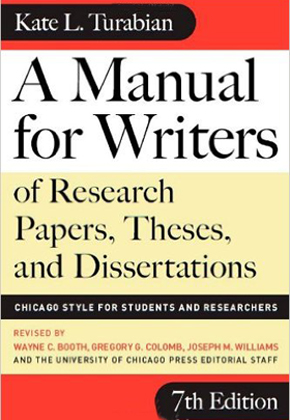
| A Manual for, Writesrs of Research Papers, Theses, and Dissertations | |
| Phụ đề: | Chicago Style for Students and Researchers |
| Tác giả: | Kate L. Turabian |
| Ký hiệu tác giả: |
TU-K |
| DDC: | 808 - Tu từ học và sưu tập văn học |
| Ngôn ngữ: | Anh |
| Số cuốn: | 1 |
Hiện trạng các bản sách
|
||||||||||||||||
» Thêm vào danh sách tác phẩm yêu thích
| A Note to Students | Xi |
| Preface | Xiii |
| Acknowledgments | Xvii |
| PART I: RESEACH AND WRITING: FROM PLANNING TO PRODUCTION | |
| Wayne C.Booth, Gregory G. Colomb, and Joseph M. Williams | |
| OVERVIEW OF PART I | 3 |
| 1. WHAT RESEARCH IS AND HOW RESEARCHERS THINK ABOUT IT | 5 |
| 1.1 How researchers think about their aims | |
| 1.2 Three kinds of questions that researchs ask | |
| 2. MOVING FROM A TOPIC TO A QUESTION TO A WORKING HYPOTHESIS | 12 |
| 2.1 Find a question in your topic | |
| 2.2 Propose some working answers | |
| 2.3 Build a Storyboard to plan and guide your work | |
| 2.4 Organize a writing support group | |
| 3. FINDING USEFUL SOURCES | 24 |
| 3.1 Understand the kinds of sources readers expect you to use | |
| 3.2 Record your sources fully, accurately, and appropriately | |
| 3.3 Search for sources systematically | |
| 3.4 Evaluate sources of relevance and reliability | |
| 3.5 Look beyond the usual kinds of references | |
| 4. ENGAGING SOURCES | 36 |
| 4.1 Read generously to understand, then critically to engage and evaluate | |
| 4.2 Take notes systematically | |
| 4.3 Take useful notes | |
| 4.4 Write as you read | |
| 4.5 Review your Progress | |
| 4.6 Manage movements of Normal Panic | |
| 5. PLANNING YOUR ARGUMENT | 48 |
| 5.1 What a research argument is and is not | |
| 5.2 Build your argument around answers to readers’ questions | |
| 5.3 Turn your working hypothesis into a claim | |
| 5.4 Assemble the elements of your argument | |
| 5.5 Distinguish arguments based on evidence from arguments based on warrants | |
| 5.6 Assemble an Argument | |
| 6. PLANNING FIRST DRAFT | 62 |
| 6.1 Avoid unhelpful plans | |
| 6.2 Create a plan that meets your readers’ needs | |
| 6.3 File away leftovers | |
| 7. DRAFTING YOUR REPORT | 71 |
| 7.1 Draft in the way that feels most comfortable | |
| 7.2 Develop productive drafting habits | |
| 7.3 Use your key terms to keep yourself on track | |
| 7.4 Quote, Paraphrase, and Summarize Appropriately | |
| 7.5 Integrate Quotations into your text | |
| 7.6 Use Footnotes and endnotes judiciously | |
| 7.7 Interpret complex or detailed evidence before you offer it | |
| 7.8 Be open to surprises | |
| 7.9 Guard against inadvertent plagiarism | |
| 7.10 Guard against inappropriate assistance | |
| 7.11 Work through chronic procrastination and writers’ block | |
| 8. PRESENTIN EVIDENCE IN TABLES AND FIGURES | 82 |
| 8.1 Choose verbal of visual representations | |
| 8.2 Choose the most effective graphic | |
| 8.3 Design tables and figures | |
| 8.4 Communicate data ethically | |
| 9. REVISING YOUR DRAFT | 98 |
| 9.1 Check your introduction, conclusion, and claim | |
| 9.2 Make sure the body of your report is coherent | |
| 9.3 Check your paragraphs | |
| 9.4 Let your draft cool, then paraphrase it | |
| 10. WRITING YOUR FINAL INTRODUCTION AND CONCLUSION | |
| 10.1 Draft your final introduction | |
| 10.2 Draft your final conclusion | |
| 10.3 Write your title last | |
| 11. REVISING SENTENCES | 109 |
| 11.1 Focus on the first seven or eight words of a sentence | |
| 11.2 Diagnose what you read | |
| 11.3 Choose the right word | |
| 11.4 Polish it off | |
| 11.5 Give it up and print it out | |
| 12. LEARNING FROM YOUR RETURNED PAPER | 120 |
| 12.1 Find general principles in Specific comments | |
| 12.2 Talk to your instructor | |
| 13. PRESENTING RESEARCH IN ALTERNATIVE FORUMS | 122 |
| 13.1 Plan your oral presentation | |
| 13.2 Design your presentation to be listened to | |
| 13.3 Plan your poster presentation | |
| 13.4 Plan your conference proposal | |
| 14. ON THE SPIRIT OF RESEARCH | 129 |
| PART II: SOURCE CITATION | |
| 15. GENERAL INTRODUCTION TO CITATION PRACTICES | 133 |
| 15.1 Reasons for citing your sources | |
| 15.2 The requirements of citation | |
| 15.3 Two citation styles |
| 15.4 Preparation of citations | |
| 15.6 A word on citation software | |
| 16. NOTES-BIBLIOGRAPHY STYLE: THE BASIC FORM | 141 |
| 16.1 Basic Patterns | |
| 16,2 Bibliographies | |
| 16.3 Notes | |
| 16.4 Short forms for notes | |
| 17. NOTES-BIBLIOGRAPHY STYLY: CITING SPECIFIC TYPES OF SOURCES | |
| 17.1 Books | |
| 17.2 Journal Articles | |
| 17.3 Magazine Articles | |
| 17.4 Newspaper Articles | |
| 17.5 Additional types of Published Sources | |
| 17.6 Unpublished sources | |
| 17.7 Informally published electronic sources | |
| 17.8 Sources in the visual and performing arts | |
| 17.9 Public documents | |
| 17.10 One Source quoted in another | |
| 18. PARENTHETICAL CITATIONS-REFERENCE LIST STYLE: THE BASIC FORM | 216 |
| 18.1 Basic patterns | |
| 18.2 Reference lists | |
| 18.3 Parenthetical citations | |
| 19. PARENTHETICAL CITATIONS-REFERENCE LIST STYLE: CITING SPECIFIC TYPES OF SOURCES | 227 |
| 19.1 Books | |
| 19.2 Journal Articles | |
| 19.3 Magazine Articles | |
| 19.4 Newspaper Articles | |
| 19.5 Additional types of Published Sources | |
| 19.6 Unpublished Sources | |
| 19.7 Informally Published Electronic Sources | |
| 19.8 Sources in the Visual and Performing Arts | |
| 19.9 Public Documents | |
| 19.10 One Source Quoted in Another | |
| PART III: STYLE | 283 |
| 20. SPELLING | 283 |
| 20.1 Plurals | |
| 20.2 Possessives | |
| 20.3 Compounds and words formed with prefixed | |
| 20.4 Line beaks | |
| 21. PUNCTUATION | 295 |
| 21.1 Period | |
| 21.2 Comma | |
| 21.3 Semicolon | |
| 21.4 Colon | |
| 21.5 Question mark | |
| 21.6 Exclamation point | |
| 21.7 Hyphen and Dashes | |
| 21.8 Parentheses and Brackets | |
| 21.9 Slashes | |
| 21.10 Quotation marks | |
| 21.11 Multiple punctuation marks | |
| 22. NAMES, SPECIAL TEMRS, AND TITLES OF WORKS | 308 |
| 21.1 Names | |
| 22.2 Special terms | |
| 22.3 Titles of works | |
| 23. NUMBER | 318 |
| 23.1 Words or numerals? | |
| 23.2 Plurals and punctuation | |
| 23.3 Date systems | |
| 23.4 Numbers used outside the text | |
| 24. ABBREVIATIONS | 331 |
| 24.1 General Principles | |
| 24.2 Names and titles | |
| 24.3 Geographical terms | |
| 24.4 Time and dates | |
| 24.5 Units of measure | |
| 24.6 The Bible and other sacred works | |
| 24.7 Abbreviations in citation and other scholarly contexts | |
| 25. QUATATIONS | 347 |
| 25.1 Quoting accurately and avoiding plagiarism | |
| 25.2 Incorporating quotations into your text | |
| 25.3 Modifying quotations | |
| 26. Tables And Figures | 359 |
| 26.1 General issues | |
| 26.2 Tables | |
| 26.3 Figures | |
| APPENDIX: PAPER FORMAT AND SUBMISSION | 373 |
| A.1 General format requirements | |
| A.2 Format requirements for specific elements | |
| A.3 Submission requirements | |
| Bibliography | 409 |
| Authors | 437 |
| Index | 439 |





